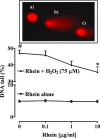Anti-proliferative effect of rhein, an anthraquinone isolated from Cassia species, on Caco-2 human adenocarcinoma cells
- PMID: 19538468
- PMCID: PMC3823282
- DOI: 10.1111/j.1582-4934.2009.00815.x
Anti-proliferative effect of rhein, an anthraquinone isolated from Cassia species, on Caco-2 human adenocarcinoma cells
Abstract
In recent years, the use of anthraquinone laxatives, in particular senna, has been associated with damage to the intestinal epithelial layer and an increased risk of developing colorectal cancer. In this study, we evaluated the cytotoxicity of rhein, the active metabolite of senna, on human colon adenocarcinoma cells (Caco-2) and its effect on cell proliferation. Cytotoxicity studies were performed using 3-(4,5-dimethylthiazol-2-yl)-2,5-diphenyltetrazolium bromide (MTT), neutral red (NR) and trans-epithelial electrical resistance (TEER) assays whereas (3)H-thymidine incorporation and Western blot analysis were used to evaluate the effect of rhein on cell proliferation. Moreover, for genoprotection studies Comet assay and oxidative biomarkers measurement (malondialdehyde and reactive oxygen species) were used. Rhein (0.1-10 microg/ml) had no significant cytotoxic effect on proliferating and differentiated Caco-2 cells. Rhein (0.1 and 1 microg/ml) significantly reduced cell proliferation as well as mitogen-activated protein (MAP) kinase activation; by contrast, at high concentration (10 microg/ml) rhein significantly increased cell proliferation and extracellular-signal-related kinase (ERK) phosphorylation. Moreover, rhein (0.1-10 microg/ml): (i) did not adversely affect the integrity of tight junctions and hence epithelial barrier function; (ii) did not induce DNA damage, rather it was able to reduce H(2)O(2)-induced DNA damage and (iii) significantly inhibited the increase in malondialdehyde and reactive oxygen species (ROS) levels induced by H(2)O(2)/Fe(2+). Rhein was devoid of cytotoxic and genotoxic effects in colon adenocarcinoma cells. Moreover, at concentrations present in the colon after a human therapeutic dosage of senna, rhein inhibited cell proliferation via a mechanism that seems to involve directly the MAP kinase pathway. Finally, rhein prevents the DNA damage probably via an anti-oxidant mechanism.
Figures






Similar articles
-
Reactive nitrogen species modulate the effects of rhein, an active component of senna laxatives, on human epithelium in vitro.J Pediatr Gastroenterol Nutr. 2002 May;34(5):529-34. doi: 10.1097/00005176-200205000-00011. J Pediatr Gastroenterol Nutr. 2002. PMID: 12050580
-
Rhein inhibits angiogenesis and the viability of hormone-dependent and -independent cancer cells under normoxic or hypoxic conditions in vitro.Chem Biol Interact. 2011 Jul 15;192(3):220-32. doi: 10.1016/j.cbi.2011.03.013. Epub 2011 Mar 30. Chem Biol Interact. 2011. PMID: 21457705
-
Rhein induces changes in the lysosomal compartment of HeLa cells.J Cell Biochem. 2022 Sep;123(9):1506-1524. doi: 10.1002/jcb.30311. Epub 2022 Jul 28. J Cell Biochem. 2022. PMID: 35901236
-
Research Progress on the Antitumor Effects of Rhein: Literature Review.Anticancer Agents Med Chem. 2017;17(12):1624-1632. doi: 10.2174/1871520615666150930112631. Anticancer Agents Med Chem. 2017. PMID: 26419468 Review.
-
Research Progress on the Positive and Negative Regulatory Effects of Rhein on the Kidney: A Review of Its Molecular Targets.Molecules. 2022 Oct 4;27(19):6572. doi: 10.3390/molecules27196572. Molecules. 2022. PMID: 36235108 Free PMC article. Review.
Cited by
-
Chemopreventive effect of the non-psychotropic phytocannabinoid cannabidiol on experimental colon cancer.J Mol Med (Berl). 2012 Aug;90(8):925-34. doi: 10.1007/s00109-011-0856-x. Epub 2012 Jan 10. J Mol Med (Berl). 2012. PMID: 22231745
-
Evidence for Anticancer Effects of Chinese Medicine Monomers on Colorectal Cancer.Chin J Integr Med. 2022 Oct;28(10):939-952. doi: 10.1007/s11655-022-3466-2. Epub 2022 Apr 13. Chin J Integr Med. 2022. PMID: 35419728 Review.
-
Kidney-targeted rhein-loaded liponanoparticles for diabetic nephropathy therapy via size control and enhancement of renal cellular uptake.Theranostics. 2019 Aug 14;9(21):6191-6208. doi: 10.7150/thno.37538. eCollection 2019. Theranostics. 2019. PMID: 31534545 Free PMC article.
-
Role of traditional Islamic and Arabic plants in cancer therapy.J Tradit Complement Med. 2016 May 21;7(2):195-204. doi: 10.1016/j.jtcme.2016.05.002. eCollection 2017 Apr. J Tradit Complement Med. 2016. PMID: 28417090 Free PMC article. Review.
-
Rhein induces apoptosis of human gastric cancer SGC-7901 cells via an intrinsic mitochondrial pathway.Braz J Med Biol Res. 2012 Nov;45(11):1052-9. doi: 10.1590/s0100-879x2012007500125. Epub 2012 Aug 2. Braz J Med Biol Res. 2012. PMID: 22850871 Free PMC article.
References
-
- Müller-Lissner SA, Kamm MA, Scarpignato C, et al. Myths and misconceptions about chronic constipation. Am J Gastroenterol. 2005;100:232–42. - PubMed
-
- Wald A. Pathophysiology, diagnosis and current management of chronic constipation. Nat Clin Pract Gastroenterol Hepatol. 2006;3:90–100. - PubMed
-
- Capasso F, Gaginella TS. Laxative. A practical guide. Milan: Springer-Verlag; 1997.
-
- Lemli J, Lemmens L. Metabolism of sennosides and rhein in the rat. Pharmacol. 1980;20:50–7. - PubMed
-
- Capasso F, Gaginella TS, Grandolini G, et al. Phytotherapy: a quick reference to herbal medicine. New York: Springer-Verlag; 2003.
Publication types
MeSH terms
Substances
LinkOut - more resources
Full Text Sources
Miscellaneous

